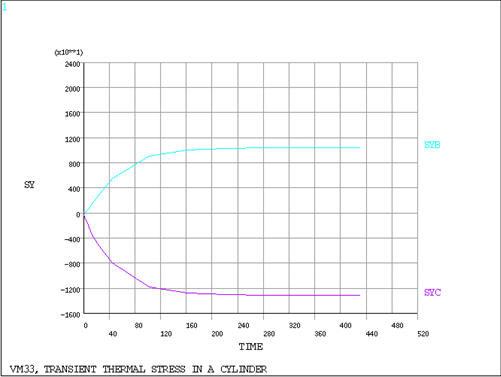VM33
VM33
Transient Thermal Stress in a Cylinder
Overview
Test Case
A long thick-walled cylinder, initially at a uniform temperature To, has its outer radius temperature raised at a constant rate of 1.0°/sec to temperature Tf. After a steady state of heat flow has been reached, determine the tangential stress at the inner and outer surfaces. Display the outer-to-inner surface temperature difference and the tangential stress as a function of time.
| Material Properties | Geometric Properties | Loading | |||||||||||
|---|---|---|---|---|---|---|---|---|---|---|---|---|---|
|
|
|
Analysis Assumptions and Modeling Notes
Due to symmetry, only a wedge of arbitrary height is required for modeling. A 5° wedge is selected to minimize curved geometry effects when using a lower order element. The thermal steady state condition is satisfied when the inner and outer wall temperature difference is constant. A transient thermal-stress analysis is required with a sufficient time period to allow the steady-state condition to be obtained. A time period of t = 430 sec is selected. The temperature Tf is assigned a value of T = 500°F such that, for a ramped load condition, the constant temperature rise of: Tf-To/Δt = 500-70/430 = 1°F/sec is obtained. Since the structural dynamic effects are not of concern, inertial and damping structural effects can be ignored, by specifying time integration for the temperature degree of freedom only. A sufficient number of elements (15) is modeled through the thickness such that an accurate thermal transient and nodal stress results are obtained.
Symmetric structural boundary conditions are used at the radial and bottom planes. Since the cylinder being modeled is long, nodes at z = h are coupled in UZ to enforce a constant axial strain condition. The reported values at t = 430 sec. should be fairly accurate since thermal steady state is achieved.




